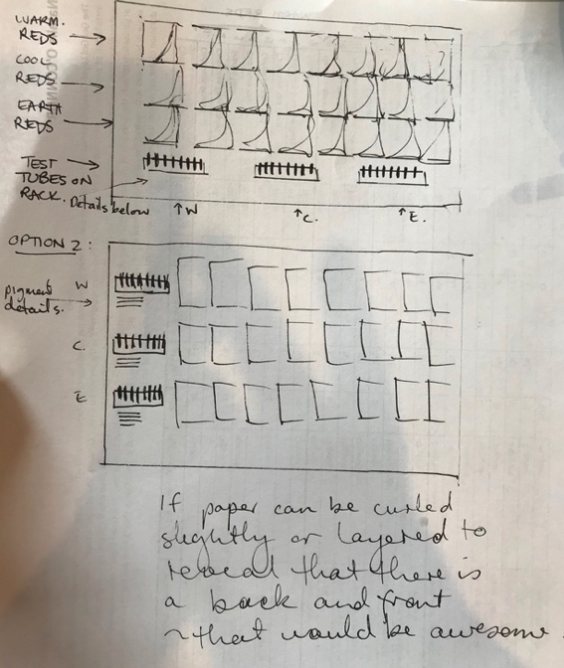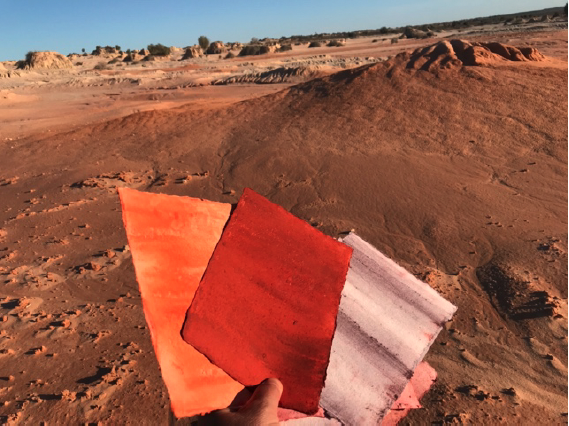Gol Gol Layer Colour Observation #6 (GGLO#6)
October – November 2019
Figure 1. Gol Gol Layer Colour Observation #6 wet state (in test tubes on the left) and #5 dry state (paper on the right) Hazelhurst Regional Gallery and Art Centre. Finalist for the Art on Paper Award. 12.09.2019 @ 1pm – 19.11.2019 @ 11am (approx. 1500 hours) by Natalie O’Connor.
Background
Gol Gol Layer Colour Observation (GGLCO) #6 continues my investigation into the inherent qualities of each red coloured artists’ pigment as a response to the oldest red layer at Mungo. This was a two-part installation shown at the Hazelhurst Art on Paper Exhibition. The red pigments in GGLCO #6 were observed on a smaller scale in test tubes in a wet state (see image x), with each pigment outlined in the table below. For over 2,000 hours (the exhibition’s duration), 24 sheets of paper were submerged in red colourant in the glass vessels. Alongside GGLCO #6 (on the left in figure 1), the corresponding pigments on the oversized sheets from GGLCO #5 were displayed. This provided a comparison with the dry state and wet state of each red pigment.
For this installation, I displayed the observational studies to present the classification of red pigments into the three red domains on the artists’ palette: 1. Warm Advancing Reds, 2. Cool Receding Reds, and 3. Earth Reds. This organisation reflects the structure of chapters in my thesis.
Scope
The scope of this stage was to observe the behaviour (movement and settling and changes in colour saturation) of 24 colourants in a wet state. These colourants were identified explicitly as a single pigment red and their interaction on a substrate after 2,000 hours. The intention was to build evidence of Field’s inherent qualities (the beauty of colour; sureness, brightness, depth; transparency and opacity) of red pigments on a substrate. Finally, this observation sought to connect the palette of red pigments on the artists’ palette and the red of the Gol Gol Layer.
Materials
24 x 5ml of each red pigment of Winsor & Newton Professional watercolour paint (see table below)
24 x glass test tubes with a secure lid
Six tube racks for wall mounting
Tap water filled to the top of the test tube
24 x sheets (14.8 x 21cm) of handmade cotton paper with no sizing.
Procedure
Figure 2: Plan for GGLCO#6 from a sketchbook. By Natalie O’Connor.
The procedure for GGLCO #6 involves three parts:
Part A: the observation of wet state pigments in the gallery setting,
Part B: The observation of paper extracted from colourant at UNSW research studios
Part C: The observation of dry state earth pigments in situ at Lake Mungo.
Each part of the observational study provided varying opportunities to observe the inherent qualities of pigments.
PART A
Figure 3: Detailed view of the 24 red pigments observed in GGLCO #6 at Hazelhurst Regional Gallery and Art Centre. Compiled images by Natalie O’Connor.
The gallery setting determined the procedure for installing, observing, and documenting GGLCO #6. A design for installation (see the plan from my sketchbook below) was made considering health and safety requirements in a public space. A space was allocated for the installation, and the gallery staff assisted with hanging dry, red-pigmented paper from GGLCO #5. These were installed beside the small test tubes of GGLCO#6, as can be seen in Image 1. The paper was curled slightly and layered to reveal a back and front. Note: I included Permanent Carmine in GGLCO #6 as I had documented this colour in the previous GGLCO #5, even though it was changed and was now not classified as a red pigment.
The cotton paper sheets were loosely rolled and submerged into the glass test tubes, filled with 25 different colourants and water. The test tubes were sealed with a lid to prevent spillage or access by children.
Once installed on preview night, the observational study presented an artist’s talk and its parameters to the public.
The red colourants were agitated twice during the exhibition. This occurred because the coloured pigments had settled unevenly, and I hoped to see the pigment across as much of the paper surface as possible.
PART B
GGLCO #6 was removed from the Hazelhurst Regional Gallery and transferred to my UNSW research studio space.
Observations were made, and the movement of the pigment and how it settled on the paper surface was recorded.
Colourants were left dry and placed in folio with written observations.
PART C
The earth red-pigmented papers were taken to the Gol Gol Layer at Lake Mungo to observe the colours in situ. See Figure 4, 5 & 6.
The earth red pigments were documented alongside the red layer.
As a practice-based researcher, I connect the material colour on my artists' palette with place and time. The Mungo National Park is a unique place that has provided me with a line of inquiry for these investigations as part of the Willandra Lakes Region and World Heritage Area. The Gol Gol Layer refers to the oldest red layer on the Mungo Lunettes. I acknowledge and pay my respects to the Elders, past, present and future, of the 3TTG’s and sincerely thank the community of Mungo. I also express profound thanks to NSW National Parks for their interest and assistance with my research.
Figure 4. Natalie O'Connor observing the dried red pigment papers of the earth colours on the Gol Gol Layer at Mungo. October 2020. Photograph taken by Nicole Walton.
Figure 5. The dry state paper samples of earth colours in the two bottom racks that were taken to Mungo to observe against the Gol Gol Layer in situ. Photo by Natalie O’Connor.
Figure 6. The dry state paper samples of earth colours in the two bottom racks that were taken to Mungo to observe against the Gol Gol Layer in situ. Photo by Natalie O’Connor.
Observations and Reflections
The Gol Gol Layer Colour Observations are a series of installations that examine the inherent qualities of red pigments. In GGLCO #6, the behaviours of 24 red pigments in a wet state were intermittently observed. Still, access to observations and thorough documentation was restricted, as it was installed at Hazelhurst Regional Art Gallery. The papers were submerged in diluted red pigments for 1,500 hours with a lid on the test tube during this time.
After the exhibition, the test tubes were transferred to the UNSW research studios, where the paper substrate was extracted and observed. After 1,500 hours, on 19 November 2019, I recorded my observations of the red pigments in GGLCO#6. I examined Field’s inherent quality of beauty of colour by observing red’s varying intensity, strength, and depth of colour. These characterisations were challenging to identify as singular pigments but became more apparent compared to each other. I observed a pigment’s depth of colour as its saturation and how intense the colour was, which implies its brilliance. Still, my observations in GGLCO #6 did not follow my previous expectations and my previous understanding of each pigment’s character. I re-evaluated my sense of brilliance and depth in Cadmium pigments. I also reconsidered my understanding of opacity and its relativity to depth and brilliance as the typical descriptions of the Cadmium colours were not observed in the observational studies.
The transcripts in each of the following sections were made following the moment of observing the extraction of the paper from the test tubes.
This video walks through the visual documentation of the GGLCO#6 as it was installed at Hazelhurst Regional Art Gallery and then observations of the wet state papers back in the UNSW studio.
Recommendations
To improve this observational study, I would extend the duration of the investigation. Each time this experiment has been done the time has increased. My ideal scenario would allow the colourant to evaporate completely. I would expect that the time required would be approximately 12 months, given the rate of evaporation seen during GGLCO #5 and #6.
I used 5ml of colourant from the Winsor and Newton professional watercolour range. I want to increase this to 10ml so the dilution of colour to water is more concentrated. I would like to see if increasing the amount of colourant affects the saturation of colour on the paper surface.
It would be beneficial to use distilled or deionised water. Tap water holds several contaminants that can affect the behaviours of some pigments. This could have caused problems with mould and fungus when the test tube had caps on them.
The paper sheets were rolled and placed inside the glass test tubes and were filled with colourant. I was hoping that this would strengthen the attachment of some pigments to the paper surface but it was difficult to determine if it had any effect. The colourant was not again after one week.
I need to review all red-pigmented colours available in watercolour by Winsor & Newton to ensure they remain classified as red pigments. Some pigments are not classified as yet by ASTM.
It was challenging to photograph and document the pigment characteristics in wet state of Part A in the gallery setting. An installation in my UNSW studio space would provide the duration required to observe and document the inherent qualities of pigments.
I decided to take the red earth samples to the site nearly a year after being created. I was working on a proposal to the 3TTG’s to do a time-based observational study at the Gol Gol Layer location. I decided that developing an artwork there was beyond the scope of my research and would not be respectful of the cultural protocols surrounding this site and the privileged access I had been granted by the 3TTG’s, World Heritage, and NSW National Parks and Wildlife.





